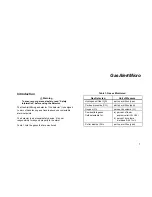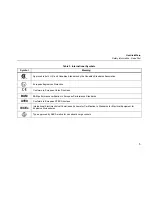
GasAlertMicro
Safety Information - Read First
a
Cautions
⇒
Warning:
Substitution of components may impair Intrinsic Safety.
⇒
Do not use the detector if it is damaged. Inspect the case before use. Look for cracks and missing parts.
⇒
If the detector is damaged or parts are missing, contact
immediately.
⇒
Ensure the battery compartment is locked in place before operating the detector.
⇒
Use only a sensor that is specifically designed for the GasAlertMicro model. Refer to
.
⇒
Calibrate the detector before first-time use and continue on a regular schedule. The schedule will depend upon
use and sensor exposure to poisons and contaminants. BW recommends that calibration be performed a
minimum of once every 180 days (6 months).
⇒
BW recommends to “bump test” the sensors, before each day’s use, to confirm their ability to respond to gas
by exposing the detector to a gas concentration that exceeds the high alarm setpoints. Manually verify that the
audible and visual alarms are activated. Calibrate if the readings are not within the specified limits.
⇒
BW recommends that the combustible sensor be checked with a known concentration of calibration gas after
any known exposure to catalyst contaminants/poisons (sulfur compounds, silicon vapors, halogenated
compounds, etc.).
⇒
The combustible sensor is factory calibrated to 50% LEL methane. If monitoring a different combustible gas in
the % LEL range, calibrate the sensor using the selected gas. High off-scale % LEL or % v/v methane readings
may indicate an explosive concentration.
⇒
Protect the combustible sensor from exposure to lead compounds, silicones, and chlorinated hydrocarbons.
Selected organic vapors (ie. leaded gasoline and halogenated hydrocarbons) may temporarily inhibit sensor
performance. However, in most cases the sensor will recover after calibration.
3














































